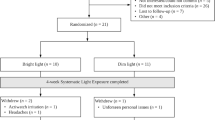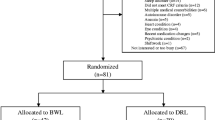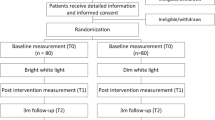Abstract
Purpose
Bright light therapy holds promise for reducing common symptoms, e.g., fatigue, experienced by individuals with cancer. This study aimed to examine the effects of a chronotype-tailored bright light intervention on sleep disturbance, fatigue, depressive mood, cognitive dysfunction, and quality of life among post-treatment breast cancer survivors.
Methods
In this two-group randomized controlled trial (NCT03304587), participants were randomized to receive 30-min daily bright blue-green light (12,000 lx) or dim red light (5 lx) either between 19:00 and 20:00 h or within 30 min of waking in the morning. Self-reported outcomes and in-lab overnight polysomnography sleep study were assessed before (pre-test) and after the 14-day light intervention (post-test).
Results
The sample included 30 women 1–3 years post-completion of chemotherapy and/or radiation for stage I to III breast cancer (mean age = 52.5 ± 8.4 years). There were no significant between-group differences in any of the symptoms or quality of life (all p > 0.05). However, within each group, self-reported sleep disturbance, fatigue, depressive mood, cognitive dysfunction, and quality of life-related functioning showed significant improvements over time (all p < 0.05); the extent of improvement for fatigue and depressive mood was clinically relevant. Polysomnography sleep findings showed that a number of awakenings significantly decreased (p = 0.011) among participants who received bright light, while stage 2 sleep significantly increased (p = 0.015) among participants who received dim-red light.
Conclusion
The findings support using light therapy to manage post-treatment symptoms in breast cancer survivors. The unexpected symptom improvements among dim-red light controls remain unexplained and require further investigation.
Trial registration
ClinicalTrials.gov Identifier: NCT03304587, October 19, 2017.

Similar content being viewed by others
Data availability
The data that support the findings of this study are available on request from the corresponding author. The data are not publicly available due to privacy or ethical restrictions.
References
American Cancer Society (2023) How common is breast cancer? American Cancer Society website https://www.cancer.org/cancer/breast-cancer/about/how-common-is-breast-cancer.html#references. Accessed 2 Jun 2023
Cheng KK, Darshini Devi R, Wong WH, Koh C (2014) Perceived symptoms and the supportive care needs of breast cancer survivors six months to five years post-treatment period. Eur J Oncol Nurs 18(1):3–9
Reich RR, Lengacher CA, Alinat CB, Kip KE, Paterson C, Ramesar S, Han HS, Ismail-Khan R, Johnson-Mallard V, Moscoso M, Budhrani-Shani P, Shivers S, Cox CE, Goodman M, Park J (2017) Mindfulness-based stress reduction in post-treatment breast cancer patients: immediate and sustained effects across multiple symptom clusters. J Pain Symptom Manage 53(1):85–95
Wu HS, Gao F, Given C (2023) Living as a survivor: sleep disturbance, fatigue, depressive mood, and cognitive dysfunction after breast cancer treatment. Cancer Nurs. https://doi.org/10.1097/NCC.0000000000001200
Nho J-H, Reul Kim S, Nam J-H (2017) Symptom clustering and quality of life in patients with ovarian cancer undergoing chemotherapy. Eur J Oncol Nurs 30:8–14
Rha SY, Lee J (2017) Symptom clusters during palliative chemotherapy and their influence on functioning and quality of life. Support Care Cancer 25(5):1519–1527
O’Higgins CM, Brady B, O’Connor B, Walsh D, Reilly RB (2018) The pathophysiology of cancer-related fatigue: current controversies. Support Care Cancer 26(10):3353–3364
Roscoe JA, Morrow GR, Hickok JT, Bushunow P, Matteson S, Rakita D, Andrews PL (2002) Temporal interrelationships among fatigue, circadian rhythm and depression in breast cancer patients undergoing chemotherapy treatment. Support Care Cancer 10(4):329–336
Amidi A, Wu LM (2022) Circadian disruption and cancer- and treatment-related symptoms. Front Oncol 12:1009064
Hrushesky WJ, Grutsch J, Wood P, Yang X, Oh EY, Ansell C, Kidder S, Ferrans C, Quiton DF, Reynolds J, Du-Quiton J, Levin R, Lis C, Braun D (2009) Circadian clock manipulation for cancer prevention and control and the relief of cancer symptoms. Integr Cancer Ther 8(4):387–397
Liu L, Rissling M, Neikrug A, Fiorentino L, Natarajan L, Faierman M, Sadler GR, Dimsdale JE, Mills PJ, Parker BA, Ancoli-Israel S (2013) Fatigue and circadian activity rhythms in breast cancer patients before and after chemotherapy: a controlled study. Fatigue 1(1–2):12–26
Blume C, Garbazza C, Spitschan M (2019) Effects of light on human circadian rhythms, sleep and mood. Somnologie 23(3):147–156 (Berl)
Czeisler CA (1995) The effect of light on the human circadian pacemaker. Ciba Found Symp 183:254–290, disc 290–232
Czeisler CA, Allan JS, Strogatz SH, Ronda JM, Sanchez R, Rios CD, Freitag WO, Richardson GS, Kronauer RE (1986) Bright light resets the human circadian pacemaker independent of the timing of the sleep-wake cycle. Science 233(4764):667–671
Dijk DJ, Boulos Z, Eastman CI, Lewy AJ, Campbell SS, Terman M (1995) Light treatment for sleep disorders: consensus report. II. Basic properties of circadian physiology and sleep regulation. J Biol Rhythms 10(2):113–125
Duffy JF, Czeisler CA (2009) Effect of light on human circadian physiology. Sleep Med Clin 4(2):165–177
Duffy JF, Wright KP Jr (2005) Entrainment of the human circadian system by light. J Biol Rhythms 20(4):326–338
Eastman CI, Martin SK (1999) How to use light and dark to produce circadian adaptation to night shift work. Ann Med 31(2):87–98
Gooley JJ (2008) Treatment of circadian rhythm sleep disorders with light. Ann Acad Med Singap 37(8):669–676
Rastad C, Ulfberg J, Lindberg P (2011) Improvement in fatigue, sleepiness, and health-related quality of life with bright light treatment in persons with seasonal affective disorder and subsyndromal SAD. Depress Res Treat 2011:543906
Tanaka K, Takahashi M, Tanaka M, Takanao T, Nishinoue N, Kaku A, Kato N, Tagaya H, Miyaoka H (2011) Brief morning exposure to bright light improves subjective symptoms and performance in nurses with rapidly rotating shifts. J Occup Health 53(4):258–266
Terman M, Lewy AJ, Dijk DJ, Boulos Z, Eastman CI, Campbell SS (1995) Light treatment for sleep disorders: consensus report. IV. Sleep phase and duration disturbances. J Biol Rhythms 10(2):135–147
Ancoli-Israel S, Rissling M, Neikrug A, Trofimenko V, Natarajan L, Parker BA, Lawton S, Desan P, Liu L (2012) Light treatment prevents fatigue in women undergoing chemotherapy for breast cancer. Support Care Cancer 20(6):1211–1219
Bean HR, Diggens J, Ftanou M, Alexander M, Stafford L, Bei B, Francis PA, Wiley JF (2022) Light enhanced cognitive behavioral therapy for insomnia and fatigue during chemotherapy for breast cancer: a randomized controlled trial. Sleep 45(3):zsab246
Jeste N, Liu L, Rissling M, Trofimenko V, Natarajan L, Parker BA, Ancoli-Israel S (2013) Prevention of quality-of-life deterioration with light therapy is associated with changes in fatigue in women with breast cancer undergoing chemotherapy. Qual Life Res 22(6):1239–1244
Johnson JA, Garland SN, Carlson LE, Savard J, Simpson JSA, Ancoli-Israel S, Campbell TS (2018) Bright light therapy improves cancer-related fatigue in cancer survivors: a randomized controlled trial. J Cancer Surviv 12(2):206–215
Neikrug AB, Rissling M, Trofimenko V, Liu L, Natarajan L, Lawton S, Parker BA, Ancoli-Israel S (2012) Bright light therapy protects women from circadian rhythm desynchronization during chemotherapy for breast cancer. Behav Sleep Med 10(3):202–216
Crabtree VM, LaRosa KN, MacArthur E, Russell K, Wang F, Zhang H, Pan H, Brigden J, Schwartz LE, Wilson M, Pappo A (2021) Feasibility and acceptability of light therapy to reduce fatigue in adolescents and young adults receiving cancer-directed therapy. Behav Sleep Med 19(4):492–504
Redd WH, Valdimarsdottir H, Wu LM, Winkel G, Byrne EE, Beltre MA, Liebman ES, Erazo T, Hayes JA, Isola L, Scigliano E, Meschian Y, Lutgendorf S, Ancoli-Israel S (2014) Systematic light exposure in the treatment of cancer-related fatigue: a preliminary study. Psychooncology 23(12):1431–1434
Starreveld DEJ, Daniels LA, Kieffer JM, Valdimarsdottir HB, de Geus J, Lanfermeijer M, van Someren EJW, Habers GEA, Bosch JA, Janus CPM van Spronsen DJ, de Weijer RJ, Marijtn EWA, de Jongh E, Zijlstra JM, Böhmer LH, Houmes M, Kersten MJ, Korse CM, van Rossum HH, Redd WH, Lutgendorf SK, Ancoli-Israel S, van Leeuwen FE, Bleiker EMA (2021) Light therapy for cancer-related fatigue in (non-)Hodgkin lymphoma survivors: results of a randomized controlled trial. Cancers 13(19):4948 (Basel)
Wu HS, Davis JE, Chen L (2021) Bright light shows promise in improving sleep, depression, and quality of life in women with breast cancer during chemotherapy: findings of a pilot study. Chronobiol Int 38(5):694–704
Wu HS, Gao F, Yan L, Given C (2022) Evaluating chronotypically tailored light therapy for breast cancer survivors: preliminary findings on fatigue and disrupted sleep. Chronobiol Int 39(2):221–232
Wu LM, Amidi A, Valdimarsdottir H, Ancoli-Israel S, Liu L, Winkel G, Byrne EE, Sefair AV, Vega A, Bovbjerg K, Redd WH (2018) The effect of systematic light exposure on sleep in a mixed group of fatigued cancer survivors. J Clin Sleep Med 14(1):31–39
Rissling M, Liu L, Youngstedt SD, Trofimenko V, Natarajan L, Neikrug AB, Jeste N, Parker BA, Ancoli-Israel S (2022) Preventing sleep disruption with bright light therapy during chemotherapy for breast cancer: a phase II randomized controlled trial. Front Neurosci 16:815872
Adan A, Archer SN, Hidalgo MP, Di Milia L, Natale V, Randler C (2012) Circadian typology: a comprehensive review. Chronobiol Int 29(9):1153–1175
Lack L, Bailey M, Lovato N, Wright H (2009) Chronotype differences in circadian rhythms of temperature, melatonin, and sleepiness as measured in a modified constant routine protocol. Nat Sci Sleep 1:1–8
Montaruli A, Castelli L, Mulè A, Scurati R, Esposito F, Galasso L, Roveda E (2021) Biological rhythm and chronotype: new perspectives in health. Biomolecules 11(4):487
Baehr EK, Revelle W, Eastman CI (2009) Individual differences in the phase and amplitude of the human circadian temperature rhythm: with an emphasis on morningness-eveningness. J Sleep Res 9(2):117–127
Duffy JF, Dijk DJ, Hall EF, Czeisler CA (1999) Relationship of endogenous circadian melatonin and temperature rhythms to self-reported preference for morning or evening activity in young and older people. J Investig Med 47(3):141–150
Eastman CI (2011) How to get a bigger dose of bright light. Sleep 34(5):559–560
Shirani A, St Louis EK (2009) Illuminating rationale and uses for light therapy. J Clin Sleep Med 5(2):155–163
Tuunainen A, Kripke DF, Endo T (2004) Light therapy for non-seasonal depression. Cochrane Database Syst Rev 2004(2):CD004050
Horne JA, Ostberg O (1976) A self-assessment questionnaire to determine morningness-eveningness in human circadian rhythms. Int J Chronobiol 4(2):97–110
Cella D, Davis K, Breitbart W, Curt G, Fatigue C (2001) Cancer-related fatigue: prevalence of proposed diagnostic criteria in a United States sample of cancer survivors. J Clin Oncol 19(14):3385–3391
Sadler IJ, Jacobsen PB, Booth-Jones M, Belanger H, Weitzner MA, Fields KK (2002) Preliminary evaluation of a clinical syndrome approach to assessing cancer-related fatigue. J Pain Symptom Manage 23(5):406–416
Van Belle S, Paridaens R, Evers G, Kerger J, Bron D, Foubert J, Ponnet G, Vander Steichel DV, Heremans C, Rosillon D (2005) Comparison of proposed diagnostic criteria with FACT-F and VAS for cancer-related fatigue: proposal for use as a screening tool. Support Care Cancer 13(4):246–254
Golden RN, Gaynes BN, Ekstrom RD, Hamer RM, Jacobsen FM, Suppes T, Wisner KL, Nemeroff CB (2005) The efficacy of light therapy in the treatment of mood disorders: a review and meta-analysis of the evidence. Am J Psychiatry 162(4):656–662
Brainard GC, Sliney D, Hanifin JP, Glickman G, Byrne B, Greeson JM, Jasser S, Gerner E, Rollag MD (2008) Sensitivity of the human circadian system to short-wavelength (420-nm) light. J Biol Rhythms 23(5):379–386
Lockley SW, Brainard GC, Czeisler CA (2003) High sensitivity of the human circadian melatonin rhythm to resetting by short wavelength light. J Clin Endocrinol Metab 88(9):4502–4505
Newman LA, Walker MT, Brown RL, Cronin TW, Robinson PR (2003) Melanopsin forms a functional short-wavelength photopigment. Biochemistry 42(44):12734–12738
Vartanian GV, Li BY, Chervenak AP, Walch OJ, Pack W, Ala-Laurila P, Wong KY (2015) Melatonin suppression by light in humans is more sensitive than previously reported. J Biol Rhythms 30(4):351–354
Zeitzer JM, Dijk DJ, Kronauer R, Brown E, Czeisler C (2000) Sensitivity of the human circadian pacemaker to nocturnal light: melatonin phase resetting and suppression. J Physiol 526(Pt 3):695–702
Schalet BD, Hays RD, Jensen SE, Beaumont JL, Fries JF, Cella D (2016) Validity of PROMIS physical function measured in diverse clinical samples. J Clin Epidemiol 73:112–118
Aaronson NK, Ahmedzai S, Bergman B, Bullinger M, Cull A, Duez NJ, Filiberti A, Flechtner H, Fleishman SB, de Haes JC, Kaasa S, Klee M, Osoba D, Razavi D, Rofe PB, Schraub S, Sneeuw K, Sullivan M, Takeda F (1993) The European-Organization-for-Research-and-Treatment-of-Cancer QLQ-C30: a quality-of-life instrument for use in international clinical-trials in oncology. J Natl Cancer Insti 85(5):365–376
Phillips AJK, Vidafar P, Burns AC, McGlashan EM, Anderson C, Rajaratnam SMW, Lockley SW, Cain SW (2019) High sensitivity and interindividual variability in the response of the human circadian system to evening light. Proc Natl Acad Sci USA 116(24):12019–12024
Acknowledgements
This study was supported by the National Institutes of Health, National Institute of Nursing Research grant number: R15NR016828.
Funding
This study was supported by the National Institutes of Health, National Institute of Nursing Research grant number: R15NR016828.
Author information
Authors and Affiliations
Contributions
Horng-Shiuann Wu, Jean E. Davis, and Feng Gao contributed to the study conception and design. Material preparation, data collection, and analysis were performed by Horng-Shiuann Wu, Feng Gao, and Charles W. Given. The first draft of the manuscript was written by Horng-Shiuann Wu and Feng Gao and all authors commented on all versions of the manuscript. All authors read and approved the final manuscript.
Corresponding author
Ethics declarations
Ethics approval
The study was performed in line with the principles of the Declaration of Helsinki. It was approved by the Institutional Review Boards at Michigan State University in East Lansing, Michigan (IRB #2776) and the Human Investigation Committee at Washington University in St. Louis, Missouri (HRPO#201703147).
Consent to participate
Informed consent was obtained from all individual participants included in the study.
Competing interests
The authors declare no competing interests
Additional information
Publisher's Note
Springer Nature remains neutral with regard to jurisdictional claims in published maps and institutional affiliations.
Rights and permissions
Springer Nature or its licensor (e.g. a society or other partner) holds exclusive rights to this article under a publishing agreement with the author(s) or other rightsholder(s); author self-archiving of the accepted manuscript version of this article is solely governed by the terms of such publishing agreement and applicable law.
About this article
Cite this article
Wu, HS., Gao, F., Davis, J.E. et al. Effects of chronotype-tailored bright light intervention on post-treatment symptoms and quality of life in breast cancer survivors. Support Care Cancer 31, 705 (2023). https://doi.org/10.1007/s00520-023-08157-9
Received:
Accepted:
Published:
DOI: https://doi.org/10.1007/s00520-023-08157-9




